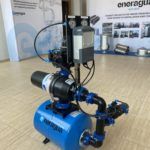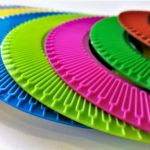
In previous articles, we have discussed the need to purify industrial waters. This time, we will delve into how this purification is carried out through the use of ring filters.
There are various types of filters on the market, but in this post, we will specifically discuss the so-called Ring Filter. We will explain how it works, but before that, we will provide a brief summary before delving into technical descriptions:
The Ring Filter is composed of discs as a filtering tool. Its main objective is to retain any type of solid present in the water. Initially focused on irrigation water, these filters gradually expanded their areas of operation to water filtration, now widely used in various industrial sectors and for many processes.
Operation: After this brief introduction, let’s describe its operation. Filtration is carried out by passing pressurized water through the set of rings with slots, stacked on top of each other, forming a hollow tube inside. The slots play a crucial role because they determine the desired filtration degree for each process.
Under pressure, these rings create small holes within this cylinder. This is where water is filtered, flowing through the outer part and entering through the holes created by the slots; this behavior is the actual filtration.
The slots are larger on the outside than on the inside of the rings. For this reason, larger particles cannot enter the interior, and smaller ones will also be retained in the process, combining surface and depth filtration.
Although the process is somewhat complex, we are talking about a relatively modern system. Its evolution in water filtration for irrigation systems can be considered updated, ensuring its functionality.
Among its advantages is the effective filtration of mineral and organic particles, with a wide range of filtration microns depending on the water specifications. Additionally, the rings have a long lifespan due to their durability and do not require extensive maintenance.
Types of Filters According to Cleaning Mode: After understanding its operation, this type of filter is divided into two types based on the cleaning method: manual or automatic.
- Manual Cleaning: This type of filter typically consists of a set of rings stacked within a cartridge. After successive filtrations, the particles previously filtered remain trapped between these rings. Thus, the filter needs to be disassembled, and manual cleaning is performed by separating the rings one by one for an efficient cleaning process. During cleaning, it is advisable to inspect the rings in case any need replacement. Replacement can be done individually or for the entire filter.
- Automatic Cleaning: This type of filter is more advanced and therefore more complex. It usually consists of the set of rings within the cartridge, a solenoid valve, and a programmer to perform the filtration and cleaning process. After successive filtration processes and through a pressure differential mechanism, the programmer activates the filter cleaning process, carried out autonomously and periodically as needed.
At Eneragua, we recommend the type of filter that can adapt to your needs. Contact us and let us know about your project; we will provide professional advice at every step.






